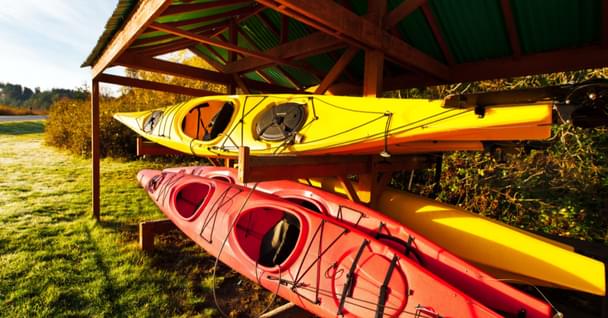3 Tips to Improve Your Low Brace
Kayak Hipster demonstrates and shares 3 things to try next time you're working on your low brace. The low brace is a great way to keep your kayak upright.
A low brace is usually used to stabilize the kayak or if you feel you're going over and you want be able to keep yourself in place. These tips might help you also if you're new to paddling, and they might just give you something to think about next time around the water.
Paddler's Box
The first thing you'll sometimes see with newer paddlers is that they're not really confident in how they're going to be doing things like a low brace. They don't realize that the water can offer a lot of support at first if you use that low brace efficiently. Oftentimes you'll see them do their low braces out in the front and kind of tapping the water. One of the things that we often talk about that will help you have a good strong starting point is the Paddler’s Box. Essentially a square that you make with your arms, your chest and your paddle, and that offers a strong and solid foundation for different strokes or movements. You're engaging a lot of your stronger muscles on your arms and your core to be able to pass that power and strength to the blades but also the Paddler's Box helps us keep our shoulders and arms safe. Now, if we take that Paddler’s Box and move it so that we can present the blades to the water for that low brace, you can lift those elbows (but not too much to keep your shoulders safe). But by having a strong Paddler’s Box and the blade close to the water, close to your belly, we can really put a lot of strength into that blade as it hits the water. We’re not putting any body parts in danger because we have a very solid foundation. We have a good grip on the paddle and our arms, our core, and everything is working together to keep the paddle in the right spot. The shaft should be close to your belly, elbows up (but not too high to keep your shoulders safe), and that way we have a strong Paddler’s Box, ready to smack the water when we feel like we’re going over.
Turn the Shaft
The second thing to think about is going for the brace, but holding it in the water for too long and when you try to bring the blade out of the water, you essentially pull yourself in and under. So if you slap the water, at first you'll have that resistance, but once the blade goes underwater if you try pulling, you're pulling yourself into the water. So as soon as you get that leverage on the water surface, remember to turn the shaft, turn the blade, before you bring it out again. So you slap, turn, and then pull up right. That way you're knifing the blade back out of the water. So we are going to hit the water, turn, bring it up.That way when you hit the water you get the purchase on the water, but then there's no resistance when you pull it back up.
Use Your Hips
The third thing to think about is the hips. Just like if you ever researched rolling, the hips and the way we move our kayak. Our top and bottom are joined at the hips and they're completely separate. You can be doing very different motions with each of those sections. So the third thing to try is when you slap the water, don't just try to bring yourself out upright as if you're just one big stiff thing. The moment you hit the water, use those hips, use your legs, you engage your lower body and you slide the kayak back under you. So we're falling over, we slap, then we slide under, and then we bring the paddle back up. What's really nice is the water allows us to slide the kayak back underneath us. So if you feel you're going over, don't just pull up with your whole body, slap and slide the kayak under, so that it can now level you out again.
Practice this when the water is warm enough so that you can take a swim. Definitely do it in a place that is okay for you to fall in because it's very common that when we're practicing our low brace, we're gonna make the mistake of falling. If you're practicing these things, give these three things a try, and see if it helps you.
Subscribe to Kayak Hipster on Youtube for more kayaking videos!
Related Articles
Kayak Hipster demonstrates 3 things to try next time you're working on your forward stroke. The forward…
Kayak Hipster demonstrates 3 things to try next time you're working on your sculling draw. An efficient…
Action cameras are everywhere in the outdoors community, and paddling adventures are an obvious match…
So, you’ve got your new kayak this season. You figured out how to transport it. Figured out how to pack…



